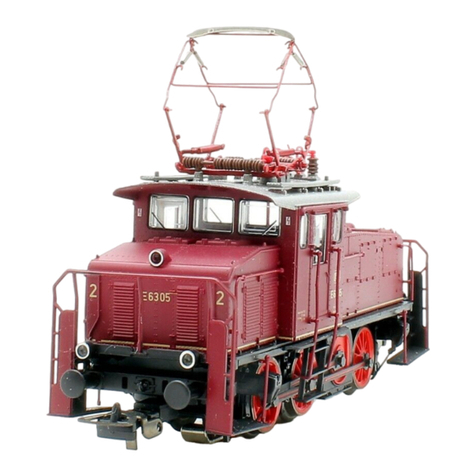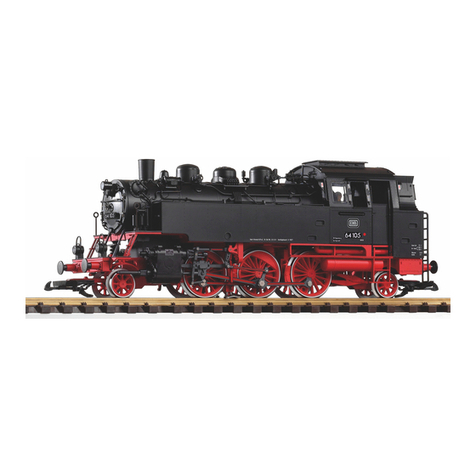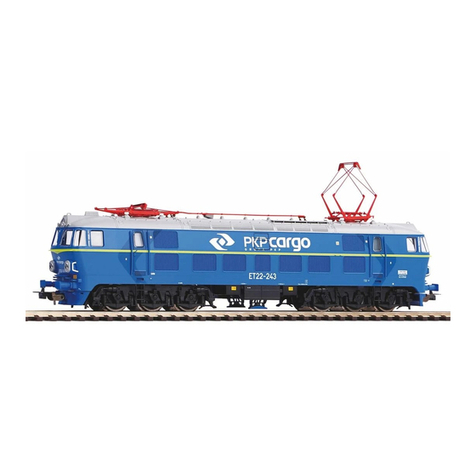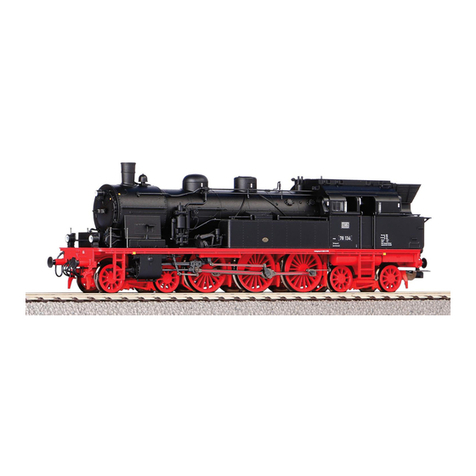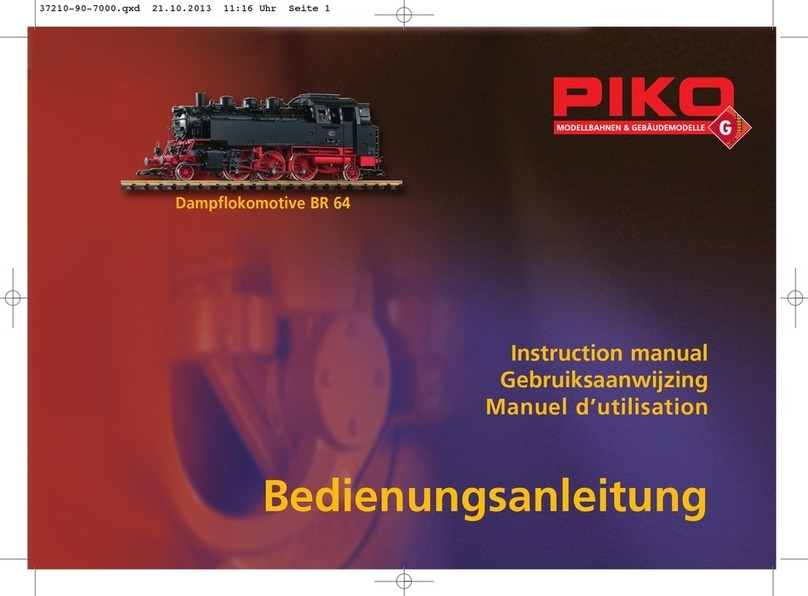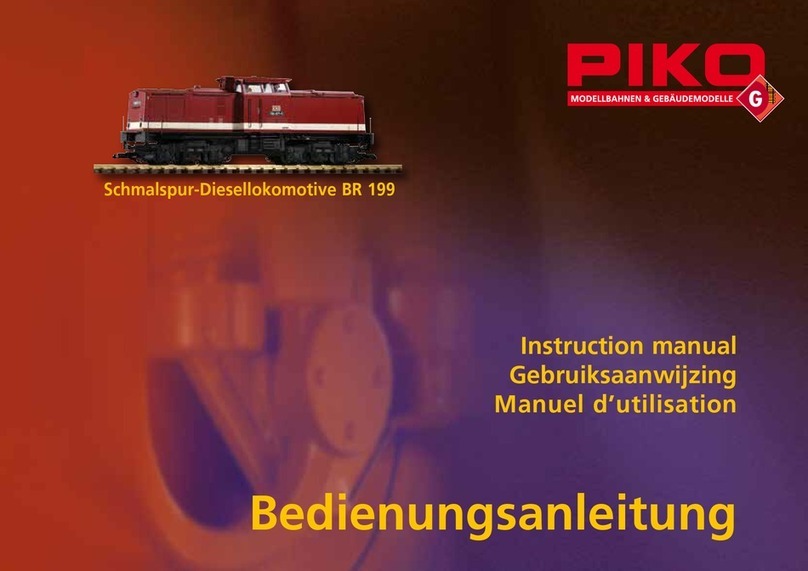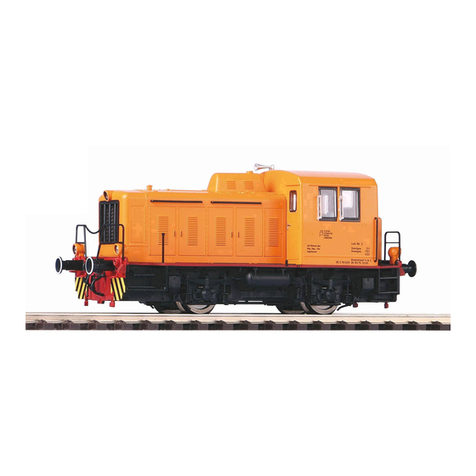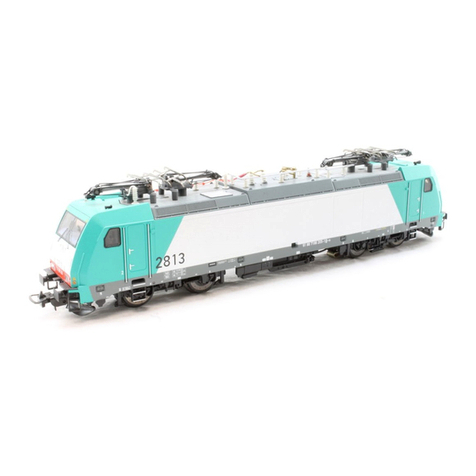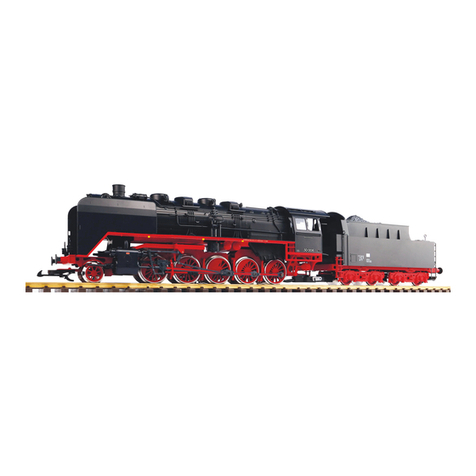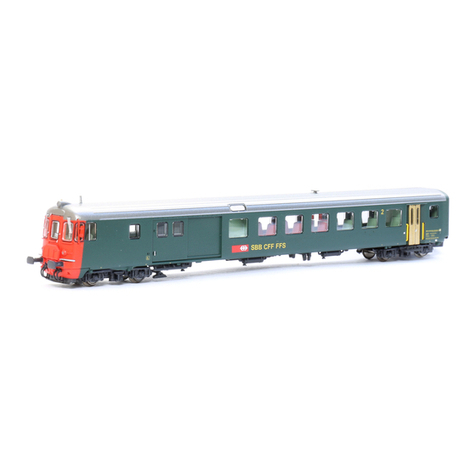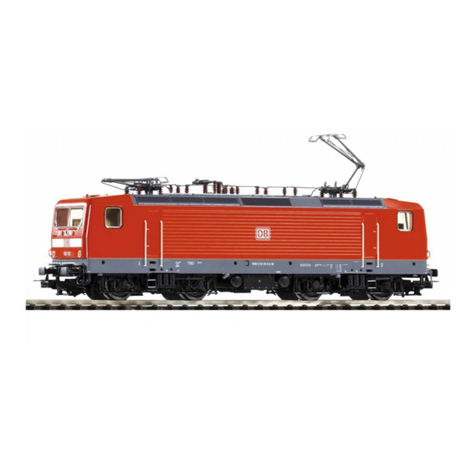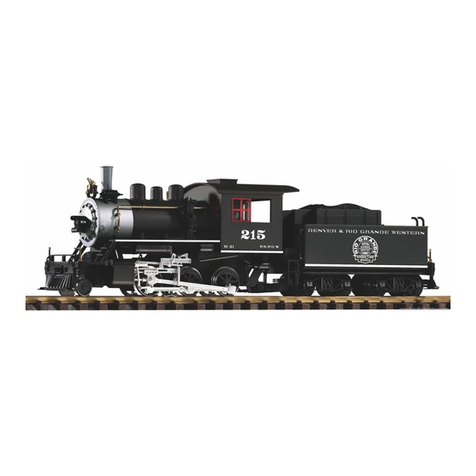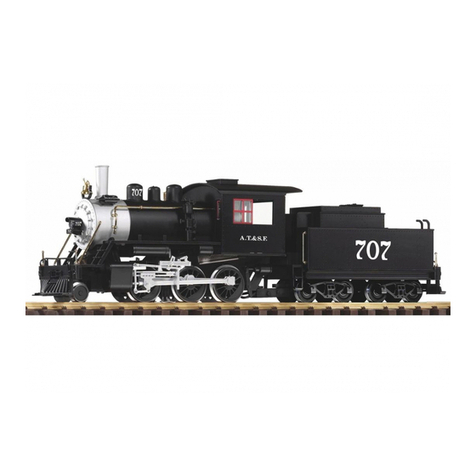
10
Analog DC peration
The model and the sound decoder are designed to be
fully functional and ready right-out-of-the-box with no
adjustments necessary. or operation using a Digital /
DCC system, refer to the section labeled “Digital / DCC
Operation”.
Power Supply
Attention! The model should only be operated on a
high-quality, electronically-regulated power supply
providing 0 to 24 volts of smooth, filtered DC, with a
capacity of at least 2 Amps and a fast-acting fuse or
circuit breaker to protect against short circuits. Do not
use a power supply which is not in safe and perfect
working condition. Older rheostat-style power packs and
“pulse” power packs will result in erratic and unreliable
operation and should not be used. The use of an
improper power supply can even damage the model and
void the warranty.
Depending on the quality of the voltage from the power
supply, some automatic sound functions may not work
correctly or may trigger continually. The sensitivity of
these functions can be adjusted using a Digital / DCC
system – See the Owners Manual for further information.
Attention! Do not exceed the model’s absolute
maximum input voltage rating of 30 volts. If the track
voltage exceeds 29 volts, the sound and motor will
automatically shut off and the front and rear lights will
flash. Decrease the voltage immediately! The sound
decoder will recover at approximately 27 volts.
perating the Model
With the throttle set to zero, the locomotive will be
motionless and silent, as it has no power. Turn the
throttle up gradually to about 5 to 7 volts to provide
sufficient voltage to power up the internal circuitry of the
loco’s sound decoder. At this point, the sound of the
dynamo (generator) will be heard, as well as the steady
sound of the blower and the occasional random pumping
of the air compressor. The smoke unit will begin to work
and the appropriate headlamp (front or rear, according to
the direction of travel) will be lighted. If the throttle is set
to move the locomotive forward, two blasts of the
whistle will sound as the throttle is increased. If it is set
to move the locomotive in reverse, three blasts will sound.
Increasing the throttle further to about 8.5 to 9 volts will
set the locomotive in motion, increasing speed as the
throttle is increased. The exhaust chuff is synchronized to
the speed of the locomotive. Note that the direction can
only be changed when the locomotive is stopped. As the
throttle is increased and the loco begins to move, the bell
will automatically start and ring for about 5 seconds.
or best operation, adjust the throttle smoothly and
gradually. Erratic movement of the throttle can produce
poor operation.
When the throttle is turned down, the sound of the
brakes squealing will be heard.A bit of practice may be
required to learn the rate of throttle decrease which
consistently triggers the brake sound.Turning the throttle
down further will bring the locomotive to a stop,
followed by a single blast of the whistle and the hiss of
steam.
Leaving the throttle set to provide about 6 volts to the
track will keep the sounds, lights and smoke operating
while the locomotive is stopped, such as while standing
at a station. A bit of experimentation will reveal the
proper throttle setting to provide operation of these
“standstill” features. After a time, the sound of the air
compressor pumping will be heard randomly.
The occasional sound of the fireman tossing a shovel or
two of coal into the loco’s firebox will also be heard.As
set from the factory, this only occurs about one of four
times when the loco stops.
Triggering Bell and Whistle Sounds
This loco also has a sensor to trigger bell and whistle
sounds when the loco passes over track magnets
(magnets not included - purchase PIKO #35268). Rotating
the track magnet 180 ° will select triggering either the
bell ringing for about 5 seconds or a grade crossing
whistle signal (two long blasts, one short, one long).
Volume Control
The sound system’s volume control is located in the
tender, under the water filler hatch cover on top of the
rear deck. Pull up gently on the hatch cover. Turn the
knob carefully to adjust the volume level.
Attention! Always put the hatch cover back in place!
Leaving the model exposed to the elements with the
cover removed can cause damage to the sophisticated
electronic components inside the tender.
Smoke Switch
An on/off switch for the smoke unit is located next to the
sound volume control.
Analog DC Features Requiring a Digital/DCC System
for Programming
This model is optimized from the factory for best
operation under most circumstances.Advanced users of
Analog DC may wish to make use of a Digital / DCC
system to change some of the many programmable
functions. Once programmed on a Digital system, most of
these functions will also operate on Analog DC. or
example, using a Digital system, one of three different
whistle tones can be chosen and this selection will
remain in effect when operating on Analog DC power.
Digital / DCC peration
This model is equipped with a sophisticated digital steam
sound decoder which has been factory-programmed and
optimized. The loco is ready for initial use with no need
for adjustments or programming. The loco will operate
immediately using a PIKO Digital System or other
NMRA/NEM-compliant DCC system designed for G-Scale
trains.This loco is not designed to operate correctly on
older digital systems (MTS I, etc.) which use only “serial”
data transmission. Because the sound decoder also
operates the motor, smoke unit and lights, many settings
(called Configuration Variables or CVs) can be adjusted to
modify how the locomotive runs as well as how it sounds.
or additional information on these features, see the
complete Owner’s Manual and Technical Reference at
www.piko.de or www.piko-america.com. Note that a
computer with Adobe® Acrobat Reader installed is
required to view and print these files.This is available as
a free download from www.adobe.com.
perating on the PIK Digital System or other DCC
system
The loco is factory-programmed to respond to Loco
Address 3. The online Owner’s Manual provides the
information needed to adjust the sound decoder’s
numerous settings (CVs) as desired.
Attention! The sound decoder in this model is a highly
sophisticated and technically complex device.The factory-
programmed settings (CVs) are the result of extensive
engineering experience and testing for optimal
performance. Changing CVs can result in poor
performance or failure of some functions to operate.This
should only be attempted by someone technically
qualified to perform these tasks successfully.
The locomotive’s sound decoder is factory-set with the
following “default” function assignments:
Function Default Setting
0 Headlight On/Off
1 Bell On/Off
2 Whistle On/Off
3 Short Whistle
4 Steam Release (Hiss)
5 (Not used)
6 Smoke Unit On/Off
7 Headlight Dimmer On/Off
8 Mute
9 Inertia Override (temporarily overrides
momentum settings)
10 Half Speed (for switching/shunting operations)
11 Brake Squeal (when moving)
Brake Release (when stopped)
12 (Not used)
Automatic versus User-Activated Features
Some features work automatically on Digital operation,
for example, steam exhaust chuff, air compressor and
coal shoveling. Other features, such as bell, whistle and
brake sounds, are user-activated by the appropriate
function button on the Digital controller.
Volume Control
The volume control knob in the tender also functions on
Digital operation. (See section above under Analog DC
Operation for important info.) Additionally, using a Digital
system, the sound decoder’s built-in mixer allows
adjustment of the master volume as well as individual
adjustment of each sound effect. The Owner’s Manual
provides info on these settings.
Smoke Switch
If the smoke switch in the tender is off, the smoke on/off
function button on the Digital controller will be of no
effect.
Track Magnets (PIK #35268)
If track magnets are installed in the track, the loco’s
built-in sensors will activate the same bell or whistle
sequences described above under Analog DC Operation.
Popular CV Adjustments
Loco Address
Using a Digital system, the address of the loco’s sound
decoder may be programmed to any address ranging
from 0 to 9,999. Note that some Digital systems can only
program or operate a more limited number of addresses.
Speed Steps
The sound decoder is factory-set to 28 speed steps. It can
also be programmed to either 14 or 128 speed steps. If
operating on a system which only supports 14 speed
steps, it will be necessary to program the loco to 14
speed steps for proper functioning of the headlights.
Whistle Tone
By programming CV 115 to a value of 0, 1 or 2, one of
three different whistle tones can be selected.
CV Reset
Programming CV 8 to a value of 8 will accomplish a
“reset” of all CVs to the factory defaults.






